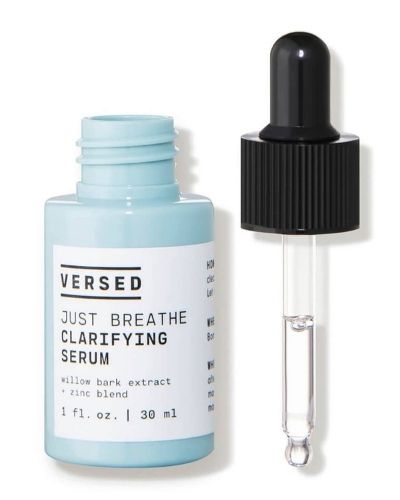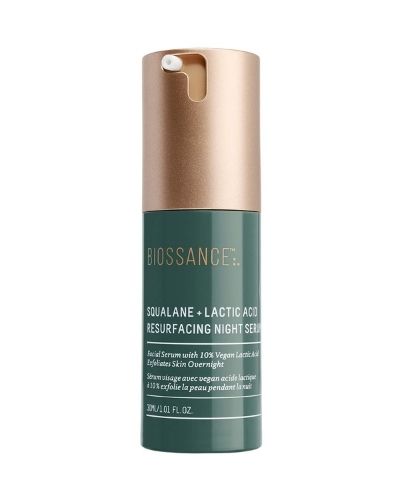Lactic acid and niacinamide can be a fantastic combo for targeting multiple skin concerns, including excess oil production, enlarged pores, uneven skin tone, rough and bumpy texture, and closed comedones.
However, as always, even though these two actives are gentle and relatively easy to use and tolerate, you need to be aware that potential side effects may occur when mixing them.
Therefore, in this article, we will talk about the benefits and risks of using niacinamide and lactic acid together, as well as how to properly combine them for best results and no unwanted reactions.

How Does Niacinamide Work?

Niacinamide, or vitamin B3, is an incredibly efficient anti-inflammatory ingredient found in many skincare products, from cleansers, serums, moisturizers, and even sunscreens.
Vitamin B3 is also an essential nutrient for your body, and some reports suggest vitamin B3 deficiency can lead to various disorders of the skin as well as kidneys and brain.
While topically applied niacinamide won’t do anything for your kidneys and brain function, it can still help balance the skin function and prevent inflammatory conditions.
Niacinamide is ideal for treating blemishes caused by inflammation due to its anti-inflammatory properties and can suppress the skin’s inflammatory response to calm redness, sores, and even rashes.
Niacinamide also encourages the production of ceramides, which are an important part of a strong skin barrier and an essential component when it comes to preventing moisture loss and irritation.
Lastly, niacinamide inhibits melanosome transfer from the pigment-producing cells to skin cells, which means it will stop the uneven deposition of pigment on a cellular level and help brighten hyperpigmentation on the skin’s surface.
Some benefits of using niacinamide include:
- Balanced oil production.
- Normalized skin function.
- Less inflammation and irritation on the skin.
- Hydration and softness.
- Improved acne breakouts.
How Does Lactic Acid Work?

Lactic acid is an exfoliating acid that belongs to the family of alpha-hydroxy acids (AHAs).
This ingredient is derived from sour milk or sugar-rich foods, and it’s a water-soluble component with a large molecular weight, making it slightly different than other AHAs, such as glycolic acid.
Due to its large molecules, lactic acid won’t penetrate deeper into the skin and will instead work on the surface, which means it will provide lighter exfoliation, making it more suitable for sensitive skin.
Lactic acid is milder than other AHAs, and it can also be used alongside other actives as it is usually very well tolerated by all skin types.
Lactic acid is also a humectant, which means it attracts water molecules and helps retain them in the skin.
When applied topically, it pulls moisture from the air and helps the skin retain it, thus hydrating and plumping the skin.
Additionally, lactic acid also promotes ceramide production, which helps strengthen the skin barrier and normalize its function.
Some benefits of using lactic acid include:
- Smoother and more uniform complexion.
- Improved hyperpigmentation.
- Dissolved closed comedones.
- Evened out skin tone.
- Refined texture.
RELATED: Best Serums for Textured Skin.
Can You Use Lactic Acid and Niacinamide Together?
It is perfectly safe to use lactic acid and niacinamide together in your skincare routine.
Lactic acid is a mild alpha hydroxy acid that exfoliates the skin, while niacinamide is a form of Vitamin B3 that balances oil production and improves barrier function.
Both ingredients are gentle on the skin and are generally well-tolerated by all skin types, including sensitive and reactive skin.
When used together, these ingredients can address various skin concerns – lactic acid helps smooth skin, increase hydration, and reduce the appearance of lines and wrinkles, while niacinamide can minimize pores and soothe redness.
Additionally, both ingredients can help promote the production of ceramides, which are essential for maintaining the skin’s moisture barrier.
This means that using lactic acid and niacinamide together can help to keep your skin hydrated, plump, and healthy.
The Benefits of Combining Niacinamide with Lactic Acid
Some benefits of using lactic acid and niacinamide together include:
- Anti Aging: A research study that subjected 52 volunteers to an anti-aging skincare routine containing alpha-hydroxy acids and vitamins B3 (niacinamide), C, and E saw significant improvement in wrinkles and fine lines without adverse effects.
- Balanced Oil Production: When used together, niacinamide can help balance oil production, while lactic acid can help refine enlarged pores.
- Smooth Skin Texture: Both niacinamide and lactic acid can help smooth out skin texture and refine superficial irregularities such as closed comedones, rough and bumpy skin texture, dry patches, and flakiness.
- Brighter Skin Tone: Consistently using niacinamide and lactic acid can help brighten and even out the skin tone, fade hyperpigmentation, and promote a healthier, more uniform complexion.
- Stronger Skin Barrier: Niacinamide and lactic acid promote the formation of ceramides, which are lipids found in skin cells responsible for retaining moisture and preventing the entry of germs into the body.
The Side Effects of Combining Niacinamide With Lactic Acid
As with any other active ingredient, the risk of potential irritation is present when using lactic acid and niacinamide together.
Using exfoliators too frequently can lead to over-exfoliated skin, which can be recognized by symptoms such as redness, itchiness, burning, and irritation when applying certain products or even when washing your face with water.
Besides that, since AHAs work on the skin’s surface, they lead to increased sensitivity to UV rays, which means you should apply sunscreen every day, especially when starting to use alpha-hydroxy acids in your routine.
If you are using AHAs but not applying sunscreen or you sweat a lot during the day, and the sunscreen rubs off, bear in mind that you may start to experience symptoms of a chemical burn, such as red or dark uneven patches on the nose, cheeks, and forehead.
This means that you should use a high protection factor of 30+ and reapply it every two hours or even more frequently if you sweat a lot.
You should also consider alternatives such as setting your sunscreen with powder sunscreen to prevent it from rubbing off. Here is an article with the best powder sunscreens with high SPF suitable for summer.
Lastly, overusing lactic acid and niacinamide or using products with high concentrations of both components can also lead to irritation, so if you start noticing signs of dryness and flaking, it’s best to minimize use or use them sparingly.
RELATED: Best Products for Dry and Flaky Skin.
How to Safely Use Niacinamide with Lactic Acid?

Niacinamide and lactic acid are water-soluble components that can be used together.
However, if you are just starting and have never used either active before, opting for products containing low concentrations of niacinamide and lactic acid is best.
For example, a 5% niacinamide and 5% lactic acid serum is a good start before you can gradually work your way up as your skin builds tolerance.
Although both ingredients are safe and relatively well-tolerated by all skin types, you shouldn’t exclude the possibility of irritation that can occur by overusing these actives.
Therefore, alongside using low-concentration products, it’s also best to use them in the evenings with a day or two break in between.
As for the order of using them, you should always use exfoliating products immediately after cleansing on clean skin and leave them to act for anywhere between 2-5 minutes.
Once the exfoliating solution is thoroughly dried, you should dampen the skin by spraying thermal water and applying a small, pea-sized amount of niacinamide on damp (not wet) skin.
You can also use lactic acid after cleansing and follow up with a moisturizer that contains niacinamide, such as EltaMD PM Therapy Facial Moisturizer or CeraVe PM Oil-Free Moisturizer.
Or, you can opt for a serum that has both, such as StriVectin’s Lactic Acid Nightly Retexturizing Serum, which contains lactic acid as well as their patented NIA-114, an optimized form of Niacin/vitaminB3 clinically proven to strengthen the skin barrier and supercharge the performance of other ingredients.

My name is Simone and I am a certified skin specialist. I created this website to teach my readers how to take great care of their skin and I also like to occasionally share my honest opinions on skincare products I’ve tried. You can learn more about me here.
